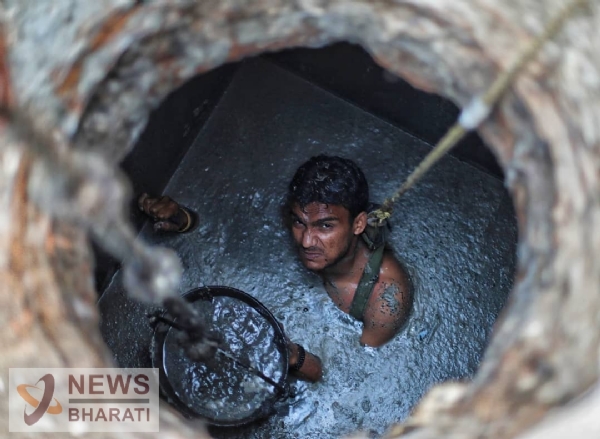Manual scavenging-free India, Manhole to Machinehole
A similar incident happened on 21st October 2022, three sanitation workers died cleaning a manhole in Wagholi, Pune in a reputed housing society. The two members among the three were technicians working for the Sewerage Treatment Plant of the Society and another guy was a Household helper. None of them were either skilled or professionals who understands the technicality of sewage line cleaning.
Total Views |
In the age of technology and innovation where India is also showing its prowess with space missions like Mangalyaan & Chandrayaan, the headlines of Indian newspapers continue to plague with news of its citizens meeting their death in the dark holes of sewer lines and septic tanks. National Commission for Safai Karamcharis states, one person has died every 5 days while cleaning sewer lines since Jan 2017. If we speak about Delhi alone, statistics reveal that 612 people have lost their lives since 1993. This is appalling and alarming for the country which aspires to be a superpower on the world stage.

A similar incident happened on 21st October 2022, three sanitation workers died cleaning a manhole in Wagholi, Pune in a reputed housing society. The two members among the three were technicians working for the Sewerage Treatment Plant of the Society and another guy was a Household helper. None of them were either skilled or professionals who understands the technicality of sewage line cleaning.
There are various socio-economic factors that have led to incidents of these causalities across India. The rapid expansion of Indian cities both vertically and horizontally has put tremendous pressure on the civic departments for keeping pace with the demands of the exponentially increasing population, in providing basic sanitation amenities. Although the cities are planned with a sewerage system, at times it becomes difficult for the services to reach the overcrowded areas as the big bulky machines cannot enter the narrow streets and lanes. Thus, the manual intervention of sewerage and septic maintenance becomes a necessity. Human labor is introduced to do filthy jobs in inhuman conditions risking their lives and often resulting in loss of life. Shouldn’t we raise the questions that who are these people who risk their lives by getting down to the sewerage system without any protection and training for a paltry daily wage? Most of them have 2 common factors which force them to take up labor work. The first factor is Caste. Across India, the safai Karamcharis come from defined castes, which have been burdened for centuries with the task of manual scavenging. For ages, they have been engaged in the work of cleaning the society of its night soil. When the cities were built and sewerage systems established, these very people continued to take up the labor of maintaining the sewerage systems. Even at the time of the Partition in 1947, some sections of the Hindu groups this particular caste involved in Safai kam were forced to stay back as ‘aap chale gaye toh hamara Paikhana kaun saaf karega’ some of these people later migrated to Kashmir, till abrogation of Article 370 they were treated as the second class citizens of India. And these Persecuted communities were given the due status of citizenship.
The second factor is poverty. Society views the work of safai karamcharis with disdain. The services rendered by safai karamcharis is unrecognized service to society which earns the labour paltry remuneration. They remain untrained, unprotected, and with no social security. Although technology is available for sewerage maintenance work, the same is not deployed as extremely cheap labor is readily available to clean the mess. The legal provision for manual scavenging since 1948, several committees and governments have been advising the abolition of manual scavenging. However, it is only in 2013 that the PROHIBITION OF EMPLOYMENT AS MANUAL SCAVENGERS AND THEIR REHABILITATION ACT was enacted to address the grim situation of safai karamcharis. The Act forbids the employment of any person for the task of manual scavenging by any agency or individual. As picking up untreated human excreta is harmful to one’s health and hygiene, the Act seeks to completely ban the practice. The act lays down the rules and procedures for the rehabilitation of manual scavengers through training in alternate employment, financial help, and help with purchasing property. Spotting an opportunity here and to resolve the issue, DICCI prepared a road map for transforming manual scavengers/safai karamcharis, who unvaryingly belong to SC/ST communities into entrepreneurs and approached the Hyderabad Metropolitan Water Supply & Sewerage Board (HMWSSB), Greater Hyderabad Municipal Corporation (GHMC)with a new concept for maintenance of sewer lines. It was the first time 160 families were identified and given a chance to upgrade their lives using advanced technology and become Saniprenuers - Sanitation Entrepreneurs. Similarly, Delhi witnessed 11 deaths in 2017 during sewerage cleaning activities. With its resolve to put an end to these accidents, an emergency meeting was called by the Honourable Chief Minister of Delhi. With DICCI s Handholding and Interventions Delhi Jal Board (DJB) Mapped to deploy 200 no’s of machines to carry out the entire work of sewer cleaning and avoid manual labor so that causalities do not occur.DICCI provided complete handholding and crafted the first model of micro-entrepreneurship amongst these sanitation workers making them direct contractors with the government. DICCI also suggested policy interventions to set up a robust mechanism and guidelines for Sewer cleaning and maintenance. These guidelines followed three aspects of the work.
dignity to Saniprenuers, the right methods to dispose of the waste, and maximum technology advancement. Both these models have successfully shown how adopting technology can resolve problems at socio-economic levels. By creating 360 Entrepreneurs an entire economy is running and delivering the service in the right manner and cost. In 2021, hon Prime Minister, Sh. Narendra Modi Ji Appealed to all Municipal Corporations to take the Oath of creating a mechanized sanitation system yet today we are seeing such incidents happen, Not just stronger policies but information, education, and communication are equally important. As a society, we must collaborate to abolish Manhole Cleaning and support the cause of mechanizing sanitation.



